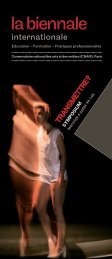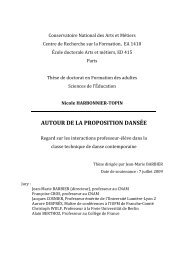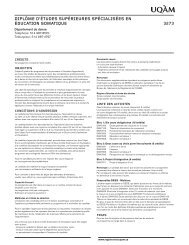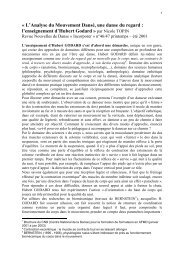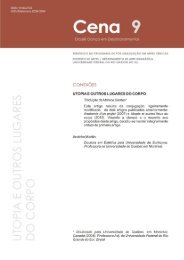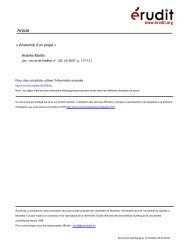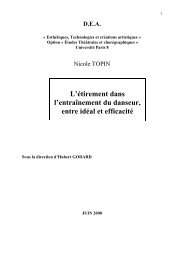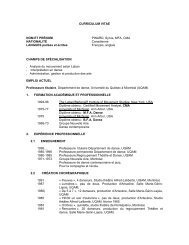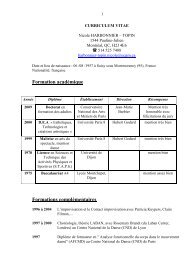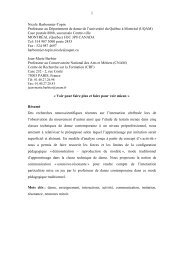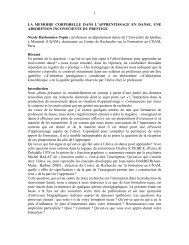Day 2 - Département de danse - UQAM
Day 2 - Département de danse - UQAM
Day 2 - Département de danse - UQAM
Create successful ePaper yourself
Turn your PDF publications into a flip-book with our unique Google optimized e-Paper software.
In this paper, I want to articulate how disi<strong>de</strong>ntification was mapped and experienced as a form of dis-orientation in Here<br />
Be Dragons, a multi-media, site-specific performance staged as part of IMPACT ‘11, wherein the audience were invited on a<br />
journey of displacement; a mytho-geographical mapping of queer, Asian-Canadian i<strong>de</strong>ntity in downtown Kitchener, Ontario. In<br />
Here Be Dragons, i<strong>de</strong>ntities-in-difference are experienced as the audience—the tourists to this domain—walk within the<br />
testimonial terrain of two young men, navigating a landscape of edges and antagonism in their hometown.<br />
“The Objects of Performance Ethnography: Traces of a Mega Event.” Keren Zaiontz (Queen<br />
Mary, University of London)<br />
Here is what remains: a pair of blue doc martens, a synthetic gown <strong>de</strong>signed expressly for the purposes of twirling in one spot<br />
(also blue), and a certificate of appreciation from the organizers. Stuffed in a plastic bag, squeezed between old files and burnt<br />
out Christmas lights, these objects once knew a larger scale—a stadium and a global audience. They are the traces of my<br />
involvement as a performer in the 2012 Paralympics opening ceremonies. That moment is now passed and so have the<br />
repertoire and gestures associated with it. In the interval following the London Summer Games these objects occupy the<br />
space of half-remembered choreography that I shared with 300 other performers. Over the summer, in East End soundstages<br />
and in empty car parks, we rehearsed the same ten-minute sequence for over eighty hours. Our section, called ‘98-Whirl’ by<br />
our mass choreographers was part of six scenes of Enlightenment, the title of the opening ceremonies. In the end, 3,000 UK<br />
resi<strong>de</strong>nts of mixed physical ability performed the scenes—the majority of them volunteer performers like myself. While the<br />
purpose of our display within the given location of the Games is now over another practice is just beginning. This one<br />
possesses no spectacle, no movement, and a commitment to a solitary raking of past traces. I am <strong>de</strong>scribing the work of<br />
translating my embodied experience as a performer into an ethnographic account. My paper will aim to engage these<br />
Paralympics performance objects alongsi<strong>de</strong> my ‘formal’ sites of information including field notes, interviews, and scholarly<br />
literature. By bringing these sites together into a single account I seek to entangle the micro and macro perspectives that<br />
constitute my participation in a mega event.<br />
b) Nature, Narrative, Nativity: Performing Indigeneity in British Columbia Bishop<br />
Open Panel Mo<strong>de</strong>rator: Jerry Wasserman (University of British Columbia)<br />
“On the edges of heritage: Locating <strong>de</strong>colonized performances in BC Historic Sites.” Amy<br />
Clausen (University of British Columbia)<br />
How do living history performances at BC historic sites invite visitors to un<strong>de</strong>rstand the heritage of the lands and peoples of<br />
BC’s Lower Mainland? In this paper I examine performative pedagogical experiences at three BC historic sites: Fort Langley<br />
National Historic Site, Burnaby Village Museum, and New Westminster’s Irving House. Costumed performances at these sites<br />
draw school groups and other audiences into Euro-Canadian settler narratives, and to a lesser extent, First Nations narratives.<br />
As the latter are often separate, both physically and thematically, from ‘the main event,’ in this paper I explore how they are<br />
marked as peripheral or at the edges of the main heritage narrative. I <strong>de</strong>monstrate how performing these narratives ‘at the<br />
edge’ misses an opportunity to engage with the complexities of colonial history.<br />
I trace the <strong>de</strong>velopment of historical narratives through costume, props and artifacts, staging, dialogue, separation or<br />
entanglement of staging and audience areas, and gen<strong>de</strong>r, age, race and ability of performers. How are some performances<br />
marked as central and others as peripheral and how might these markings be undone to prompt greater awareness of<br />
colonized histories? My analysis critiques liberal and nostalgic traditions in historic sites, in favour of more <strong>de</strong>liberately<br />
provocative theatrical practices. In addition to beginning the process of <strong>de</strong>colonizing the ‘heritage’ experience in BC, I argue<br />
that this approach makes for a far more complex and fulfilling audience experience. My research draws from Scott<br />
Magelssen’s Living History Museums (2007), an analysis of living history performance in the United States.<br />
“Honest and Humble Beginnings for Edgy Intercultural Canadian Theatre: The Artwork of<br />
Anthony Walsh and the Inkameep School Children.” Matthew “Gus” Gusul (University of<br />
Victoria)<br />
The Provincial Archives of British Columbia holds a collection of Anthony Walsh’s work with the Inkameep reserve from 1932-<br />
42. In the archive are several versions of a play script that was written by the Inkameep School Children. In the introduction for<br />
this play Walsh writes,<br />
This play is based on a Nativity Tale which has been written by the children of the Inkameep <strong>Day</strong> School in the Okanagan<br />
Valley, British Columbia. The Tale which was recently published, <strong>de</strong>picts the Nativity as seen through the eyes of Indian<br />
Children. Instead of the events taking place in Palestine, they occur in the Okanagan Valley, and the rabbits, <strong>de</strong>er, and<br />
chick-a-<strong>de</strong>es take the place of the ox and the ass. (Walsh)<br />
The story being told is neither an Indigenous folk tale nor a biblical text. It is a new shared memory. This play script is a shared<br />
cultural enunciation between the Christian Nativity story and the spiritually significant land and animals of the Inkameep<br />
people. In this re-conceptualized artwork, each religion is simultaneously risking being tainted by an outsi<strong>de</strong> force while also<br />
opening itself to gain a new perspective on their stories and sacred images. What occurs in this artwork is a look at the nativity<br />
story that opens a dialogue between Indigenous spirituality and Christianity. Intercultural theorist Homi Bhabha posits a space<br />
where intercultural communication occurs. He refers to this as the “Third Space.” This is an area in which communication<br />
happens between two cultures. It is in this space that two cultures can communicate both their collective and individual<br />
10



